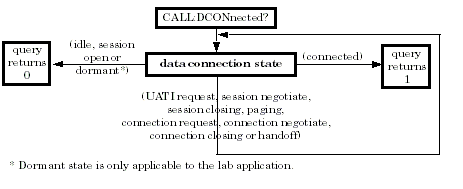CALL:DCONnected
- CALL:DCONnected[:STATe]?
- CALL:DCONnected:ARM[:IMMediate]
- CALL:DCONnected:ARM:STATe?
- CALL:DCONnected:TIMeout
CALL:DCONnected[:STATe]?
|
This command queries whether or not the data connection is in the connected state (see Connected State for a description of this data connection state).

|
|||
|
The query behaves differently if the data connection state change detector (see Data Connection State Change Detector ) is armed when the query is sent:
Using the CALL:DCONnected? query in conjunction with the data connection state change detector is useful in determining whether an attempt to open a connection has been successful. See Open a Connection from the Test Set and Data Connection State Synchronization . |
|||
|
Test Application Revision: A.01.20 and above |
|||
OUTPUT 714;"CALL:DCONnected:STATe?" ! Queries whether the data connection state is connected. |
|||
CALL:DCONnected:ARM[:IMMediate]
|
Arms the data connection state change detector. See Data Connection State Change Detector . This is an overlapped command, and therefore has a Pending Operation Flag (POF) associated with it. The POF is set when the change detector is armed, and cleared when the change detector is disarmed. See Data Connection Processing Event Synchronization for more information about the behavior of overlapped commands. |
|
|
Test Application Revision: A.01.20 and above |
|
OUTPUT 714;"CALL:DCONnected:ARM" ! Arms the data connection state change detector. |
|
CALL:DCONnected:ARM:STATe?
|
Queries the arm state of the data connection state change detector. This command never hangs and immediately returns a one if the detector is armed, or a zero if the detector is not armed. See Data Connection State Change Detector . |
|
|
Test Application Revision: A.01.20 and above |
|
OUTPUT 714;"CALL:DCONnected:ARM:STATe?" ! Returns the arm state of the data connection state change detector. |
|
CALL:DCONnected:TIMeout
|
Sets/queries the maximum time the test set will wait for the data connection state change detector to become disarmed (see Data Connection State Change Detector ). Default setting units are seconds. To set timeout time in units other than seconds, include an optional unit specifier in the command string. |
|
|
Test Application Revision: A.01.20 and above |
|
OUTPUT 714;"CALL:DCONnected:TIMeout 3" ! Sets the CALL:DCONnected:STATe? query timeout time to 3 seconds. OUTPUT 714;"CALL:DCONnected:TIMeout 500 MS" ! Sets the Sets the CALL:DCONnected:STATe? query timeout time to 500 milliseconds. |
|